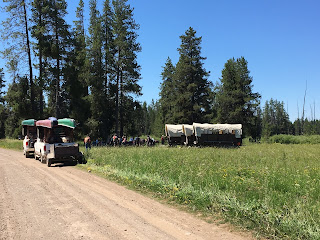While dodging storms and sticky mud, we continued along the historic Monida & Yellowstone stagecoach line linking the rail station at Monida, Montana to Yellowstone National Park. This route, which was laid in the late 1800s, by 1915 carried some 20,000 visitors per year into Yellowstone. Today we hardly saw a soul along the whole route, most of it having been made obsolete by modern highways.
Once again the trail gained elevation and crossed the Continental Divide, this time reaching a mere 7120 feet at Red Rock Pass.
Descending from this pass, we entered the Henry's Fork caldera, the remnants of a massive volcanic explosion that is still highly active today in the form of Yellowstone's geological marvels.
The plaque shows the caldera rim, which is clearly visible in the distance we'd ridden from.
The landscape changed dramatically as we entered the Caribou-Targhee National Forest, where we stopped to camp at Mesa Falls.
The river plunged through massive volcanic boulders.
Time to try out the cigars and bourbon we'd bought in Jackson Hole.
After leaving camp the next morning, only a few minutes of riding took us out of the volcanic gorge and forest and into a completely different landscape dominated by Idaho's famous potato fields. Pulling into a small farming town, we enjoyed one of the great delights of travel--the greasy bacon-and-eggs breakfast--and soon after had left the spuds and picked up the forested stage coach route again. This was also part of the cycling route, as tire-tracks attested--although I would not have enjoyed riding on this loose surface.
Before long we encountered actual stage coaches. They didn't seem like the friendliest bunch, so we snuck some pics and hightailed it on our way before they could get out the guns.
As we approached Yellowstone for the second time, we wound through charred forest recovering from massive fire damage. Those mountains on the horizon would swell to become the Grand Tetons further south.
Although we had our park passes, there was no park gate on our approach through the mountains, and before long we popped out at the park gas station we'd visited the week prior. Time for ice cream!
Amazingly, there was little traffic through Yellowstone and we carved pristine asphalt as we worked our way across and out the other side, this time heading east instead of south to Jackson Hole.
The pavement continued to rise until we topped out at a high pass into the Wind River district. This was probably the highest elevation we'd reached yet, and my little 250 struggled to make power. Although Pete was also on a 250, he was significantly lighter and cut a much slimmer profile which more than compensated for the additional 5HP of my bike. Of course Jeff, on his 650, had plenty of juice to stay ahead of the cars. And there it is, the Wind River:
After descending into the river valley, the trail immediately climbed the far side into the Wind River Range via Union Pass, revealing some of the most spectacular views and riding of the trip. Behind us lay rainbow-colored mountain sides carved by wind and water, and further in the distance lay the storm front we'd weaved our way through over the past few days. Now it was all clear skies of a high pressure system, holding the front at bay to our north.
Many options to camp, and we settled on an area beside a river that turned out to be a popular put-in for fishermen.
Seem dusty lads showed up in their UTV and we had a good laugh comparing off-roading notes.
The river was ice-cold but offered the opportunity to rinse our dusty selves and riding gear. In the mountain air, everything--including my Klim suit--was bone-dry in two hours. Dinner of chicken and dumplings was one of the tastiest freeze-dried meals I'd ever eaten.
Unfortunately the diner, which was further along than expected, wasn't open until 11 and here it was around 9:30. We rode with stomachs growling towards Pinedale, the nearest sign of civilization. The whole geography had transformed into bleak high desert with low scrub, few trees, even fewer people, and many antelope springing along through the sage. Fantastic riding at wide open throttle with the Wind River Range off to our left, the Antelope Range to our right, the sun beating down overhead, and cool dry air blasting into our faces.
Eventually we reached Pinedale, a frontier town with wide streets, wide trucks, and an air of independence. At our brunch stop at a cafe, we met Ethan, a young guy who looked like he was on military leave, who had pulled up on a KLR with some gear strapped on, but no riding gear save a helmet. He'd spent the last day here, and recommended we look around, particularly the Museum of the Mountain Man.
Turns out we were firmly in the land of Hugh Glass, the trapper played by Leonardo Dicaprio in "The Revenant". Pinedale, turned out to have a fascinating history in the fur trade, being a main stopping point of the Mountain Men who plied their trade through the Rockies. Each year, the Mountain Men would convene for a few weeks at a different location (Pinedale included) to trade goods, drink, and build contacts and teams for the year ahead. Movies like The Revenant seem to barely scratch the surface of how unimaginably tough and resourceful these traders were, surviving on skill, luck, and pure guts in such a hostile environment.
In the next post, I'll share some of the amazing artifacts in the Pinedale Museum of the Mountain Man, which is a must-see if you pass through the South Pass area.
Part 8


























No comments:
Post a Comment